VALLEJO — Boaters in Vallejo have a problem. Access points for the Mare Island Strait and the Napa River are restricted, gated, or impassable because of thick layers of silt and mud. The city’s waterfront – a pleasant stroll from the historic downtown – has been touted as an asset, a bootstrap for the city to pull itself out of the economic slump it has suffered since the Mare Island Naval Base closure in 1996. But decades of neglect are making it more and more difficult to enjoy.
Plans for waterfront development have languished. Existing recreational water access points have deteriorated to the point that it’s a challenge to launch even a small, flat-bottomed kayak. Vallejo is the only Bay Area waterfront city that’s not on the San Francisco Bay Water Trail, a network of small boat launching and landing sites. Businesses like Dolphin Charter Tours and the Northern California Pirate Festival suffer when they can’t dock their vessels or navigate the strait, which is partly what led the pirate festival to seek new facilities for future events.
“It's the amenities that make a city livable,” said former Vallejo City Councilmember Stephanie Gomes. “It’s the amenities that get lost when you have an extremely limited budget. And unfortunately, those amenities are also what brings in economic development.”
The public boat launch was last dredged 25 years ago. The water is so shallow that it is navigable only by low-draft vessels during high tide. The city’s Municipal Marina suffers from a damaged seawall and silt buildup that has trapped boats in their berths, and a boat ramp at the former fishing pier site next to state Highway 37 is fenced off 400 feet from the water at the end of a neglected gravel road.
A large portion of former U.S. Navy land on the Mare Island shoreline has been available for development since 1998, but no public water access is planned on the island.
The privately owned Vallejo Yacht Club is now the only well-maintained boating facility on the Vallejo waterfront, where a $70 monthly membership is required to rent a slip. The yacht club is filled close to its full capacity, and no live-aboard slips are currently available.
Stephen Souza, one of the founders of the grassroots Vallejo Kayaking and Biking group, said that the Vallejo waterfront used to be a vibrant recreational community. “There were boats everywhere, water skiing, jet skiing, and lots of small boats also,” he said. “I think it’s ironic that we had all of this access when Mare Island was such a restricted zone, when it was a nuclear shipyard.”
A 1999 advisory report on the Vallejo Waterfront Master plan by the Urban Land Institute states that “Vallejo has a beautiful waterfront, with parks and open space and great potential that immediately can begin to improve the city's image.” It recommended that to spur economic development, the city should create waterfront programs, such as a community sailing school, kayak lessons, boat parades, and a boat-building program for teens that could be associated with local schools and the California Maritime Academy.
This theme is consistent with Vallejo’s General Plan, which mentions the benefits of providing access for in-water recreational activities.
But no in-water programs have been created. The only elements of the city’s waterfront plan that have been developed are parking facilities, a transit center, and the controversial office building at 400 Mare Island Way that replaced a mature redwood grove.
“We're called a waterfront city,” said Brenda Plechaty, president of the Straits of Mare Island Rowing Club and Marina Advisory Committee member. “All of the promotional things for Vallejo show the waterfront. But for some reason putting money into the waterfront never seems to be a priority.”
Vallejo Municipal Marina
The city-owned Vallejo Municipal Marina is in crisis. It hasn’t been dredged since 2018, the seawall that protects it from silt deposits is falling apart, and many of its docks and structures are deteriorating.
Dennis Allbright wrote in a Sept. 16 letter to the Vallejo Times-Herald that the silt buildup has rendered the marina essentially useless. “Many have become ‘stuck in the mud,’ unable to move or sell their boats,” he wrote.
The marina is down to about 30% occupancy as boaters have fled to better facilities, while the city has raised berth rents every year for the past seven years.
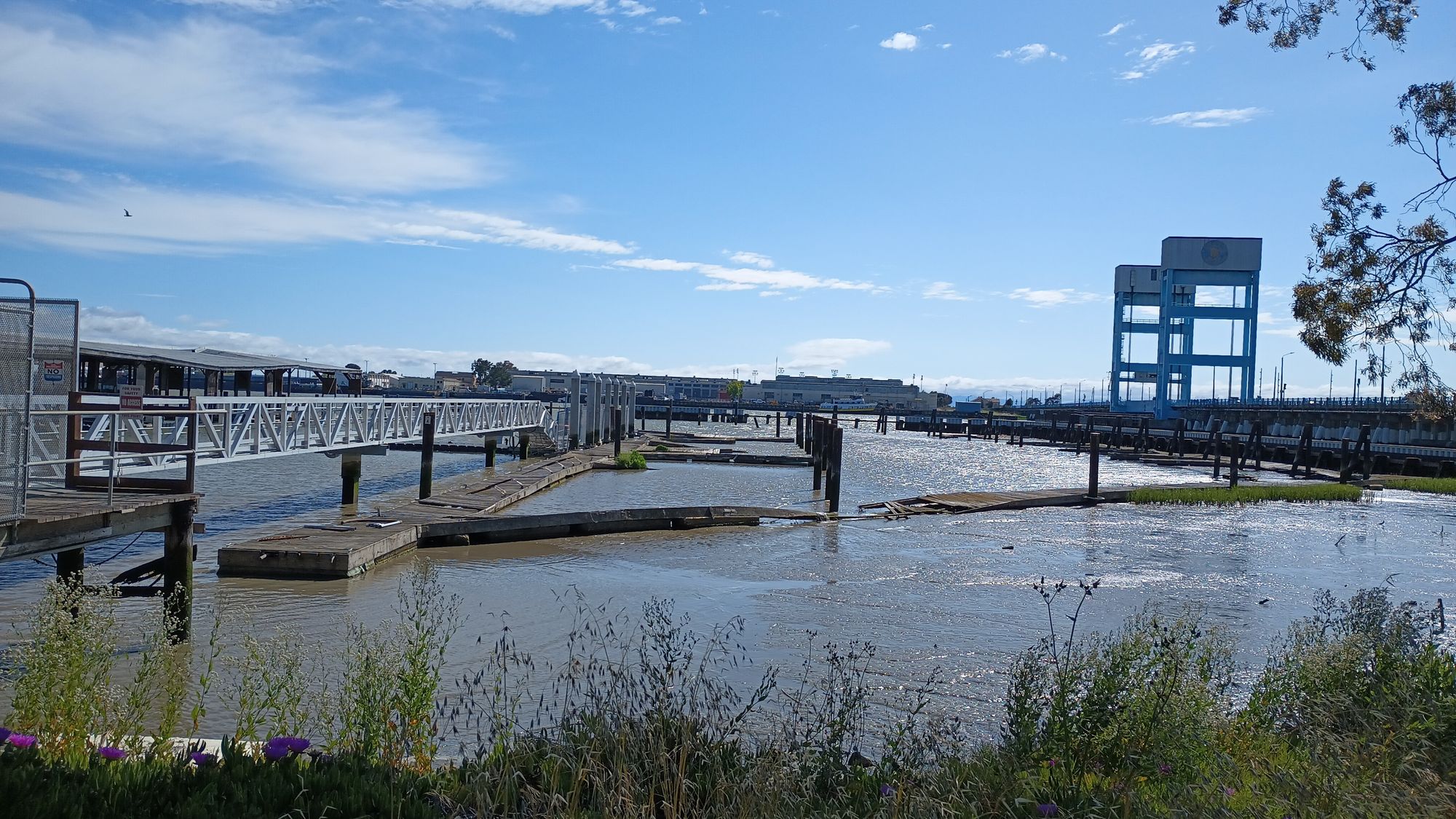
Mare Island Heritage Trust president Myrna Hayes serves as tour guide with Dolphin Charters LLC, which picks up passengers at the southern side of the marina. She said the high silt level impairs the company’s ability to book cruises. “Sorry, we can't have your birthday trip because we can't get our boat in and out of the marina,” Hayes said.
“The Napa River has the fastest siltation rate of any river in the bay,” Hayes said. “It can deposit as much as 14 inches a year.”
The Vallejo City Council has sought to add funds during recent budget cycles to dredge the marina, but has instead funded other priorities, like planning for a new police department headquarters.
Straits of Mare Island Rowing Association board member Margaret Cromwell addressed the council on June 6, as the council prepared to pass its next annual budget, to implore the city to restore the marina.
“Without an intact protective seawall, the marina will continue to act as a catch pan for silt and sludge carried down by the river,” she said. “To correctly care for this major asset of our city, we need a rebuilt seawall and regular dredging.”
Cromwell said the rowing association has lost two of their whaling boats because they sat in mud until the wood rotted. “We’ve lost new members because every low tide we cancel practice,” she said.
“We're not the only people paying the price. Private yachts, local charter businesses and fishing boats are being damaged,” Cromwell said. “Consistent dredging is necessary to maintain a healthy and functional Marina and should be part of the marina’s regular budget.”
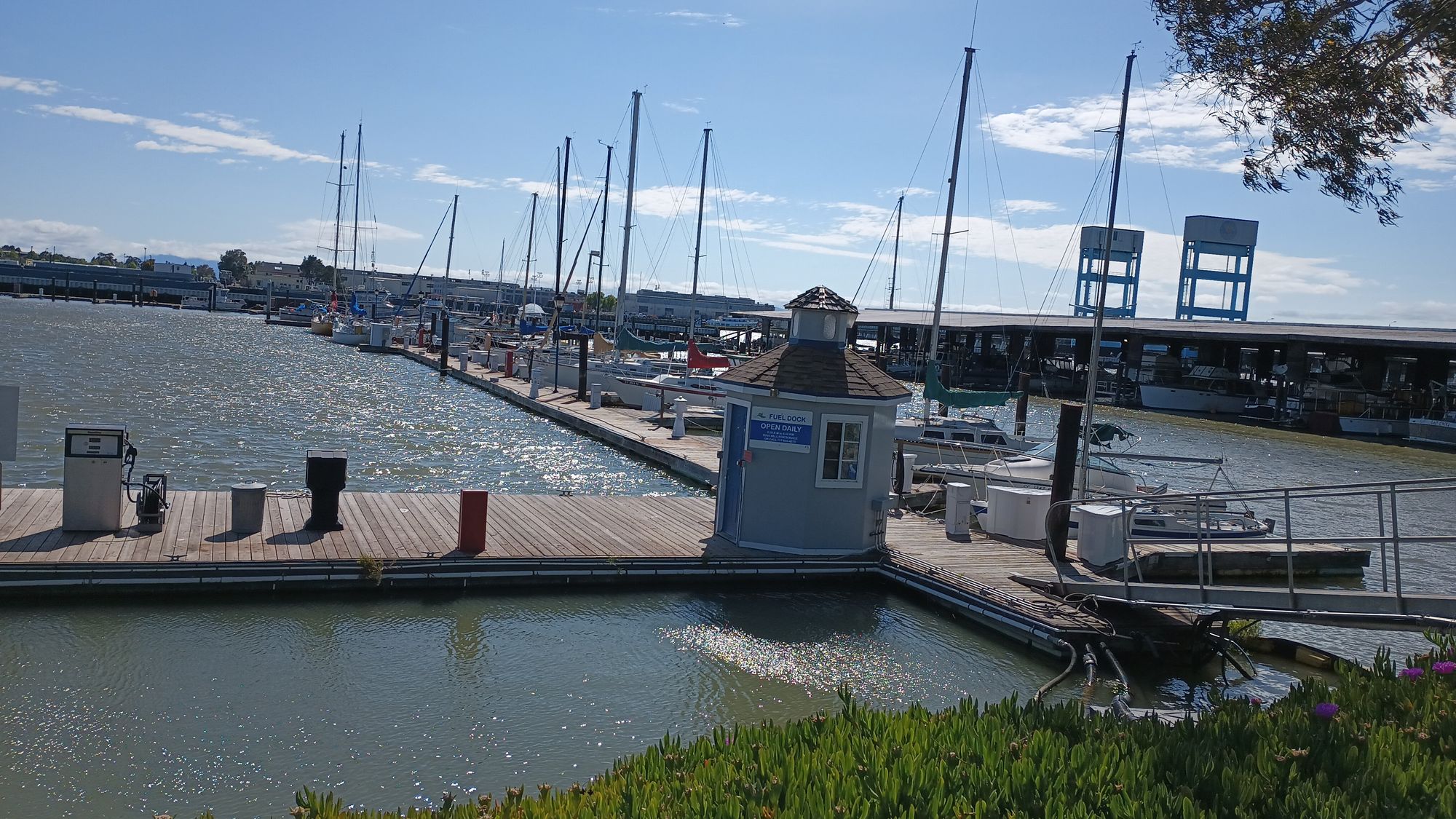
The city’s proposed budget included $500,000 from the city’s general fund for a mini-dredging project at the southern entrance of the marina for a “one-year respite.”
Public Works Director Melissa Tigbao reported that the marina needs $8.1 million for a complete dredging, and that $1.2 million should be allocated for annual maintenance dredging in the future.
Seawall repair estimates came in at $2 million, and additional funding for dock repair would bring the total needed investment to $15 million.
Finance Director Rekha Nayar said, “The $500,000 is just getting us that little piece for a year. We don’t have that $15 million for the big project.”
But the proposed budget also called for $600,000 to study how to rebuild the police headquarters and the council voted to spend general fund money on the police building while tabling marina dredging until September. Vallejo intends to seek federal American Rescue Plan Act funds for the project.
Tigbao said in an interview that boaters making trips upriver have told her they would like to be able to stop in Vallejo to gas up and rest before making a longer trip north, but at low tide the marina looks like a sandbar. She said she has tried her best to make the city council understand the need for marina maintenance. “But if I don't have the funding, I can't do anything,” she said.
Public Boat Launch
Brinkman’s Marine boating supply store was evicted from the public boat launch site at 139 Curtola Parkway in 2014 to make way for a PG&E environmental cleanup project that is scheduled for completion next year. The marine store, bait shop, gas pump, boat storage shed and bathrooms were demolished to make way for soil remediation.
The city has kept the boat launch and fishing pier access open during the remediation, but with no maintenance, the boat launch is becoming unusable.
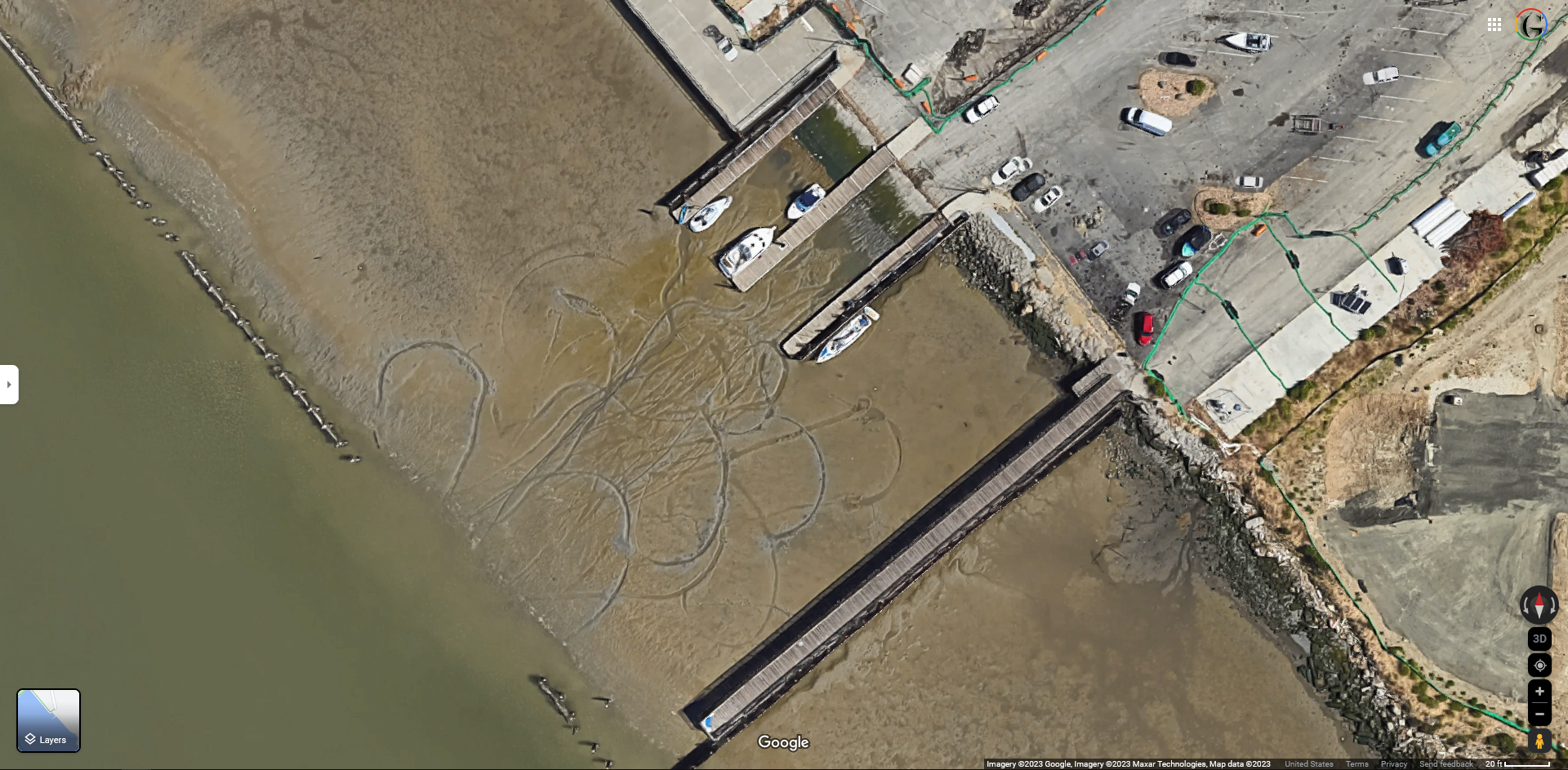
A row of posts in the water mark the location of the old seawall. A deep field of muck extends 200 feet from the shore at low tide, when curved gouges cut by boat propellers during aborted docking attempts become visible. The facility’s three floating piers weren’t designed to fall onto the mud during low tide, which can cause them to crack. One of them is visibly damaged and barricaded from public use.
As boaters abandon Vallejo for launching ramps in Benicia and Napa, their absence makes room for a new clientele. The parking lot is now filled with unhoused people’s RVs, cars and tents, an additional deterrent to some boaters.
“Even if you can get your boat out, if you hit the tides just right, you can't leave your boat or your trailer there because it's just not safe,” Plechaty said.
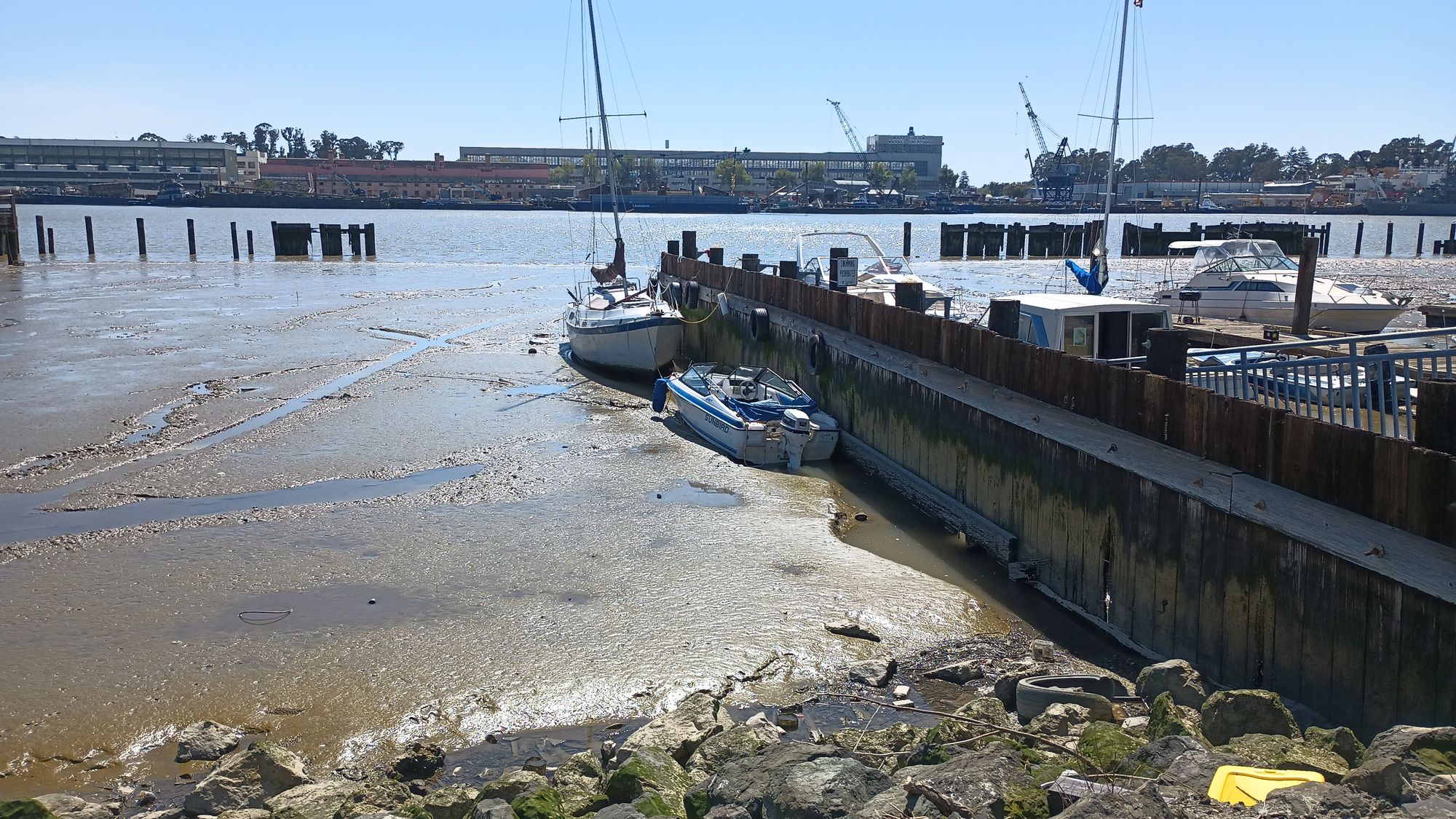
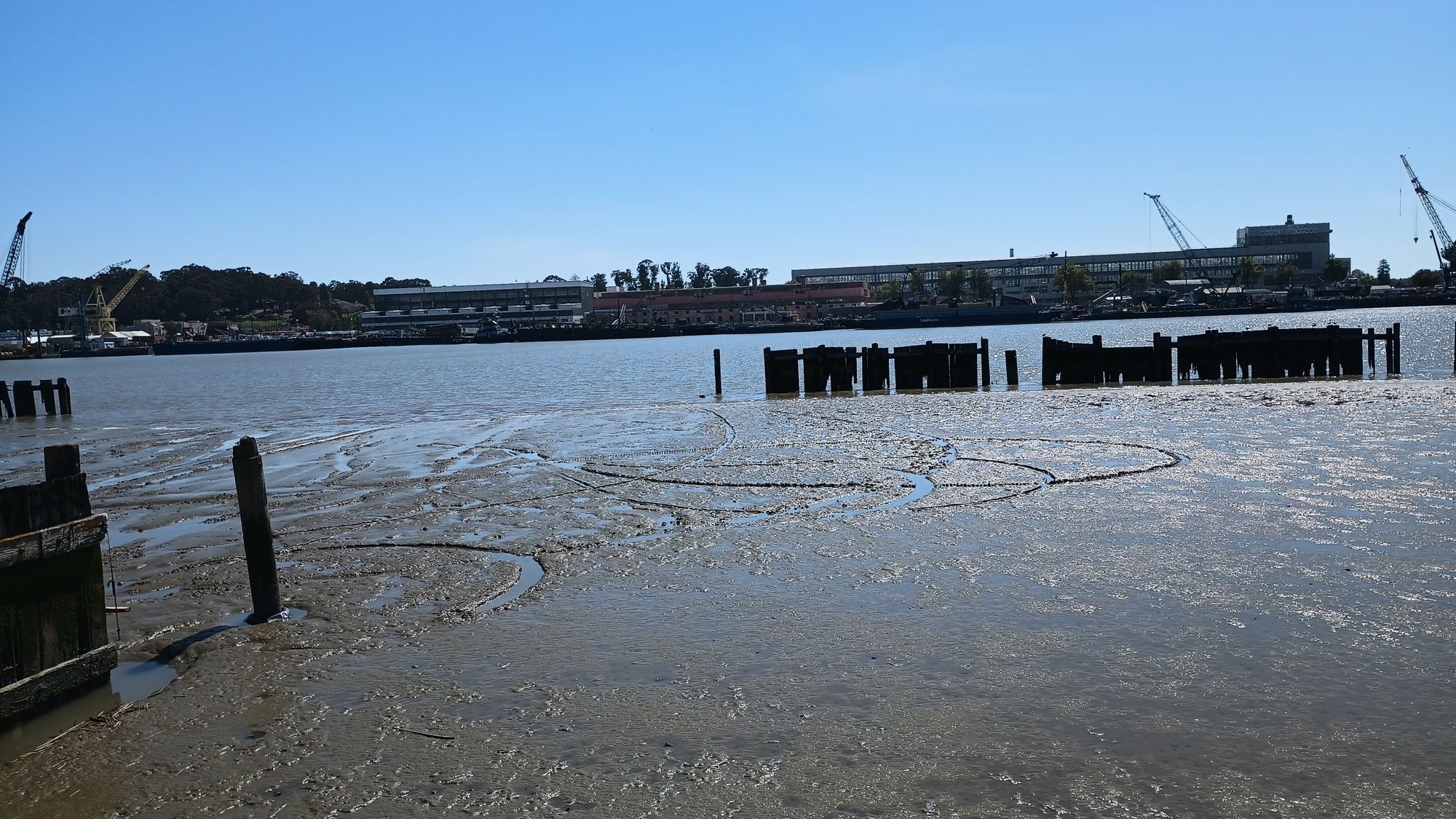
Public boat launch at low tide. Photos by Gretchen Zimmermann
Former City Councilmember Tom Bartee said that maintenance dredging of the boat launch stopped about 20 years ago, after the City Council approved a waterfront plan that suggested relocation of the launch ramp further south. The southern waterfront parcel that includes the boat launch was removed from the plan in 2016 because of the PG&E remediation.
That plan is now obsolete, according to Economic Development Department Director Michael Nimon. “We’re bracing for a new Specific Plan effort on the Waterfront that the City will be kicking off later this year,” Nimon wrote in a June 14 email.
The city and PG&E applied for a permit to reconstruct the parking lot and add a public restroom in March. Once the plans are complete and approved by the San Francisco Bay Conservation and Development Commission, the city will have to relocate the encampment before work can begin.
The city has not yet applied for permits for dredging or for pier and seawall repair.
Navy dredging at Mare Island used to reduce silt buildup on the opposite shore
When the Navy was active at Mare Island, the U.S. Army Corps of Engineers kept a 600 foot-wide channel along the island side of the strait dredged to a depth of 26 to 30 feet until 1994 to accommodate large battleships and submarines.
Civilian watercraft and passenger ferries don’t need water that deep, but a shallower channel slows the current and causes more rapid sediment accumulation throughout the strait.
Water Emergency Transportation Authority spokesperson Thomas Hall said that the Navy’s cessation of dredging of the channel, plus the impacts of climate change, has led to increased sedimentation throughout the strait, which impacts the dredge cycle of the mainland Vallejo Ferry Terminal.
“We have historically had to dredge every four or five years. That cycle is now up to two years,” Hall said. “Even outside of the dredge cycles we'll have some king tide episodes where we have to change our schedule or cancel some runs out of the Vallejo terminal because it's just too shallow right there at the docks.”
WETA has plans to relocate the ferry dock into deeper water to reduce their dredging requirement, and to make it easier for the ferries to dock.
U.S. Rep. John Garamendi, D-Vallejo, held a press conference at Mare Island in March 2022 announcing a $13 million investment that will enable Mare Island Dry Dock to service Navy ships and bring more jobs to Vallejo. He added a provision that authorizes the Secretary of Defense to conduct a study on dredging a small portion of the Mare Island Strait to restore its usability for future commercial shipbuilding, but far less than the Navy used to dredge.
Kayakers’ plight
When Souza launched the Vallejo Kayaking and Biking group in 2014 he had a vision. “I had this wild idea to put bicycles and kayaks by the ferry,” Souza said. “Therefore, I would attract more foot traffic into downtown.”
Despite his efforts to establish small boat access at several sites on the waterfront, the kayaking group now has no practical access to Mare Island Strait or the Napa River, and conducts most of their outings at Lake Chabot in Dan Foley Park.
Kayaks are easy to transport and can navigate very shallow water, so they can put in where larger vessels can’t. They’re also more susceptible to tides and currents than larger motorized boats.
Embarking from the public boat launch during an incoming tide is ideal for traveling north toward the Napa River, but not so desirable when an outgoing tide flows toward the sewage treatment plant. A variety of waterfront access points would allow the kayakers to choose the best site for the marine conditions.
But now with no practical access to Mare Island Strait, Lake Chabot has become the group’s regular meeting place. The quiet lake is ideal for beginners, but experienced kayakers tire of it quickly.
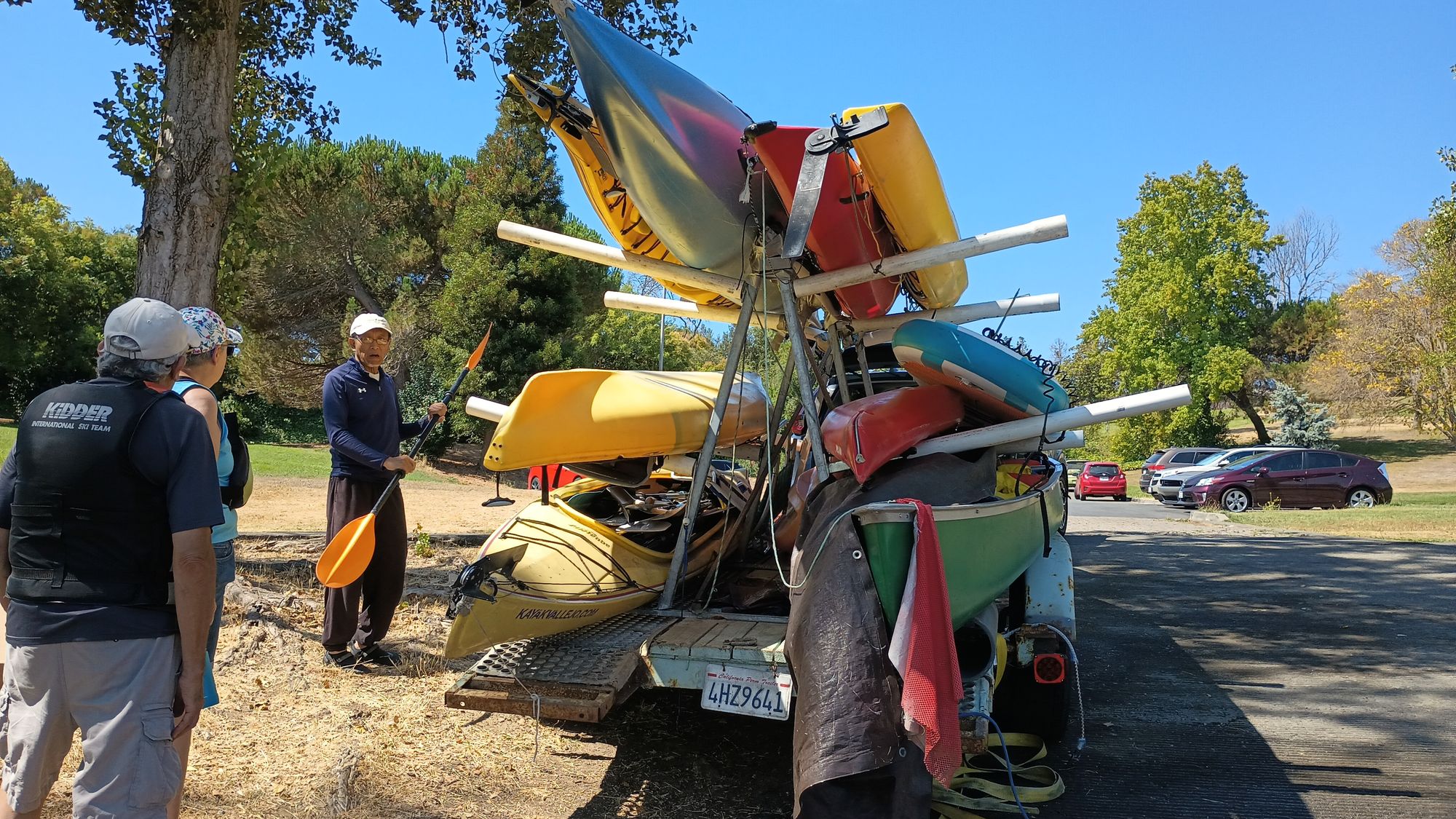
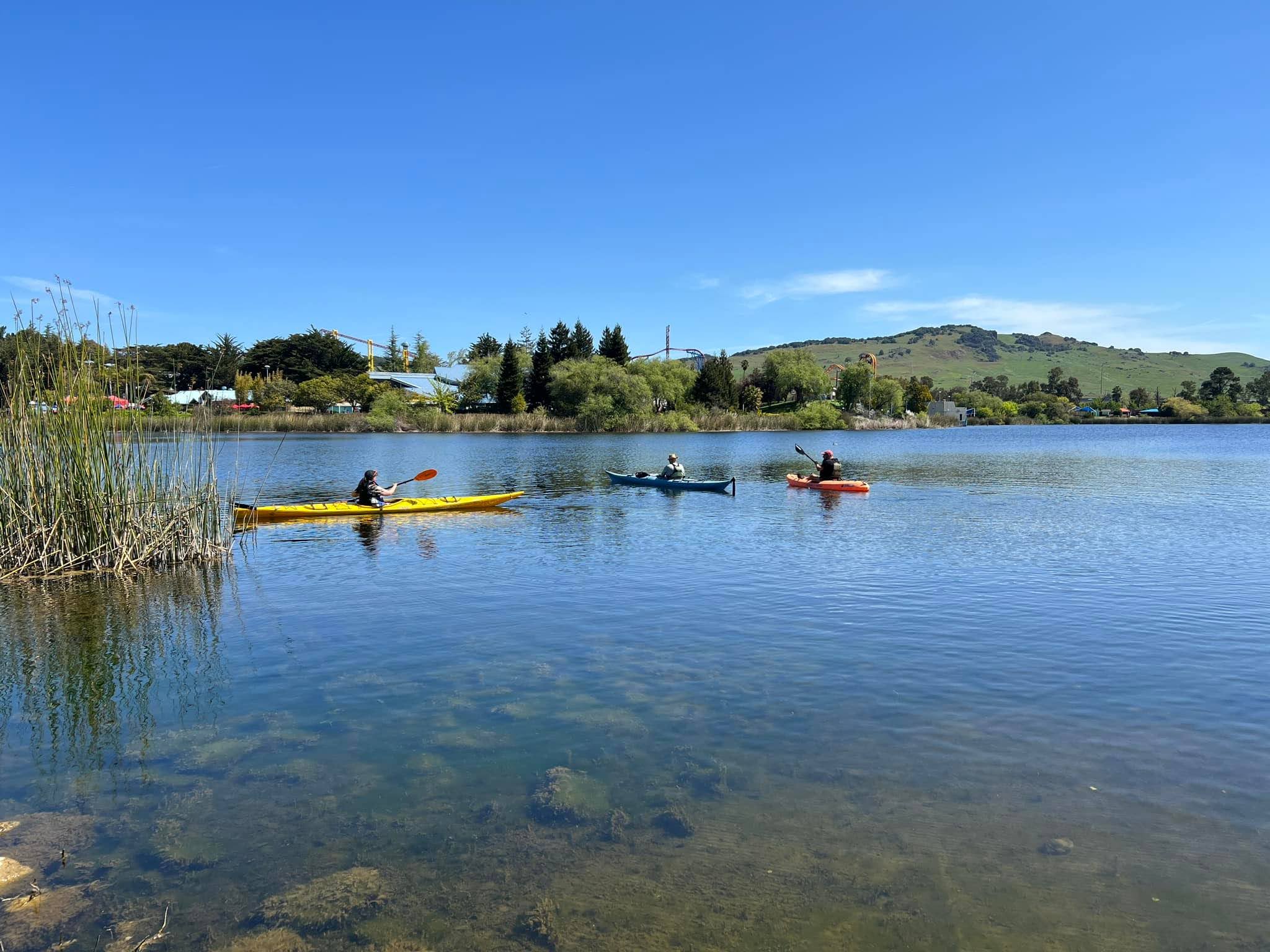
Left: Kayak group volunteer Ken Szutu talks about oars with newcomers to Lake Chabot. Photo by Gretchen Zimmermann. Right: Kayakers at Lake Chabot. Photo by Stephen Souza
“Lake Chabot is cute, it’s pretty, but it's not a challenge,” Vallejo Kayaking and Biking co-founder David Belef said. “It's a nice place to enjoy yourself, but there's only so much fun you can have on a small little lake that you've done twice, three, 100 times already.”
Belef says the challenges of wind, tides and currents in the river north of Vallejo are great fun, and he enjoys changes in scenery. “The sunsets and views from there are amazing,” Belef said. “One of the beautiful things about a river and open water is you can have a destination.”
The kayaking group had a key to the guest dock at the municipal marina and enjoyed unfettered access during the first couple years of their existence. The San Francisco Bay Water Trail – a network of non-motorized small boat launching and landing sites – briefly listed the marina on their map as a proposed trailhead.
But the groups’ relationship with the marina soured, and new policies, like reservations required a week in advance, were imposed to discourage them. The kayaking group used to announce the location of each week’s outing no earlier than three days in advance, when marine weather forecasts are reasonably accurate.
The current marina manager Travis Lund has gone further. “Access for kayakers within the marina would cause a safety hazard for both the kayaker and the recreational boater,” Lund said. “It would put them in competition for space and cause a potential hazard.”
Belef noted that the Bay Water Trail people had no issue with kayak safety at the marina. “It’s my opinion that there is a NIMBYism,” Belef said. “I have changed it in this situation to mean ‘Not In My Boat Yard.’”
Souza said the marina maintenance manager once even verbally accosted him and accused the kayakers of being freeloaders. “I said, ‘You know, I'm volunteering my time to make Vallejo better. How is that a freeloader?’” Souza said.
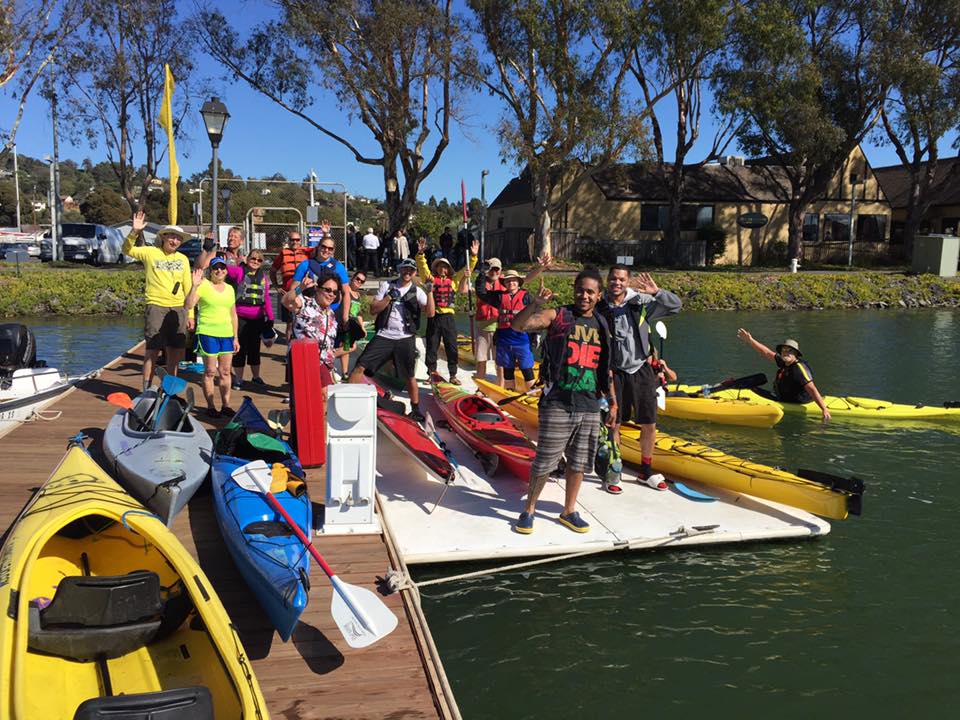
Marina Advisory Committee member Kenneth Wright said security is an issue for people who live aboard their boats. He said the only way he thinks the city would be open to providing access to the kayak ramp is if they moved the gate further down the dock to keep kayakers away from the berthing slips.
Wilson Avenue boat ramp
A cement boat ramp and shards of wooden pier posts at the end of a long dirt road are all that now remain of a once-bustling marina behind the Sunshine Smoothies juice bar.
Bartee said that 50 or 60 years ago there were buildings on the 1,060 foot-long fishing pier that ran alongside the Highway 37 bridge. “That used to be the old Vallejo Boat Works. There used to be a bait shop and a retail store and boat rentals and stuff like that,” Bartee said.
Souza said it was a big business when he used to boat on the Napa River in the mid to late 1970s. “I remember pulling up to the pier, and you could get gas and beer and sandwiches right there.”
The property is owned by the State Lands Commission and managed by the city of Vallejo. The old boat ramp is on the downstream side of a point of land bordered by a salt marsh, where it’s protected from the current and less prone to sediment buildup than other sites along the east side of the river.
Recent efforts to improve boating access to the site backfired after the Vallejo Public Works Department fell afoul of the The San Francisco Bay Conservation and Development Commission.
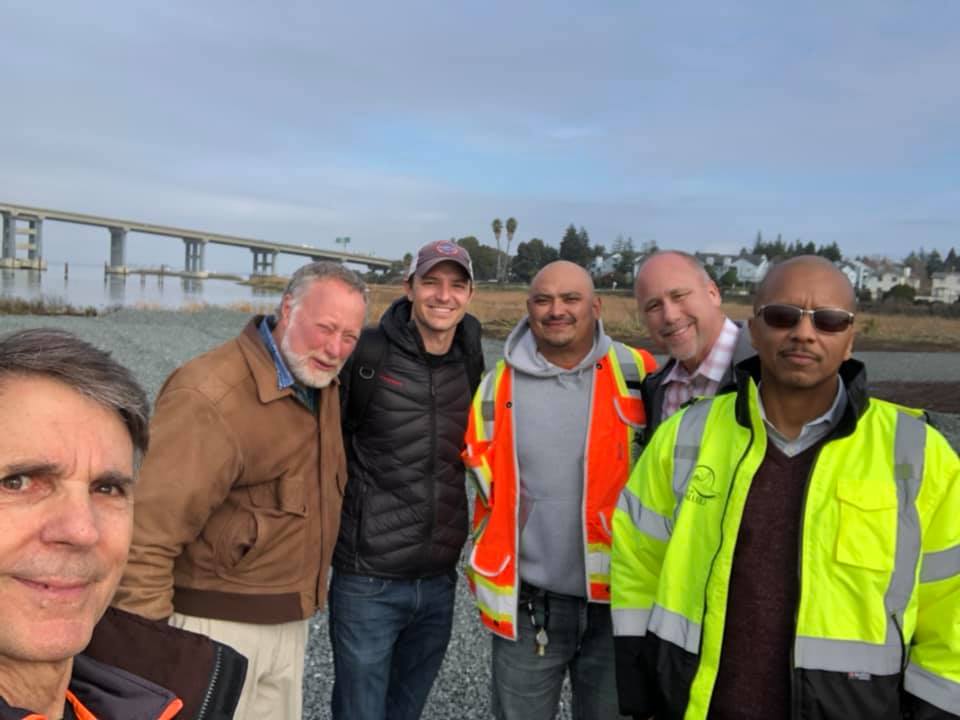
In 2019, Souza met with former City Manager Greg Nyhoff and Terrance Davis, who was director of public works at the time, about establishing three kayak access points on the strait and the river. Nyhoff told Davis to “just get it done” and start at Sunshine Smoothies, according to Souza.
“I was jumping for joy,” Souza said. “They cleared the whole area, and they poured that gravel down, and then all of a sudden they locked the gate.”
Davis told Souza that because the city didn’t get a permit from The San Francisco Bay Conservation and Development Commission, they had to pick up every piece of gravel or incur a fine.
The road to the concrete launch ramp is now blocked from automobile traffic. It is possible to carry or roll kayaks through the pedestrian access 450 feet over the pitted dirt road to the boat launch, but the added time and effort to get the kayaks to and from the water is a big deterrent for a large group on a short outing. There’s also a shortage of parking outside the boat launch area.
Belef points out that the gate is even more problematic for disabled boaters. “There is a gentleman who has a handicap accessible van with an outrigger canoe on the top of it,” Belef said. "He’s wheelchair bound, for crying out loud. Talk about having issues with access!”
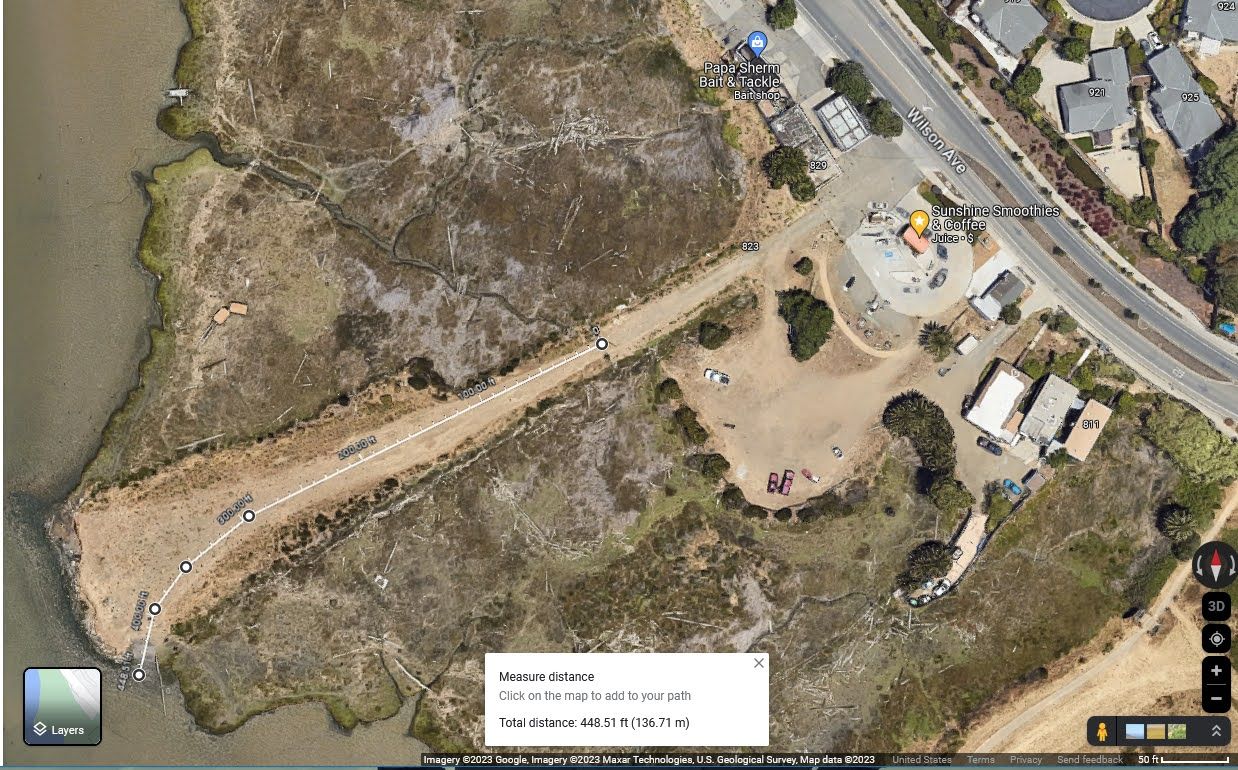
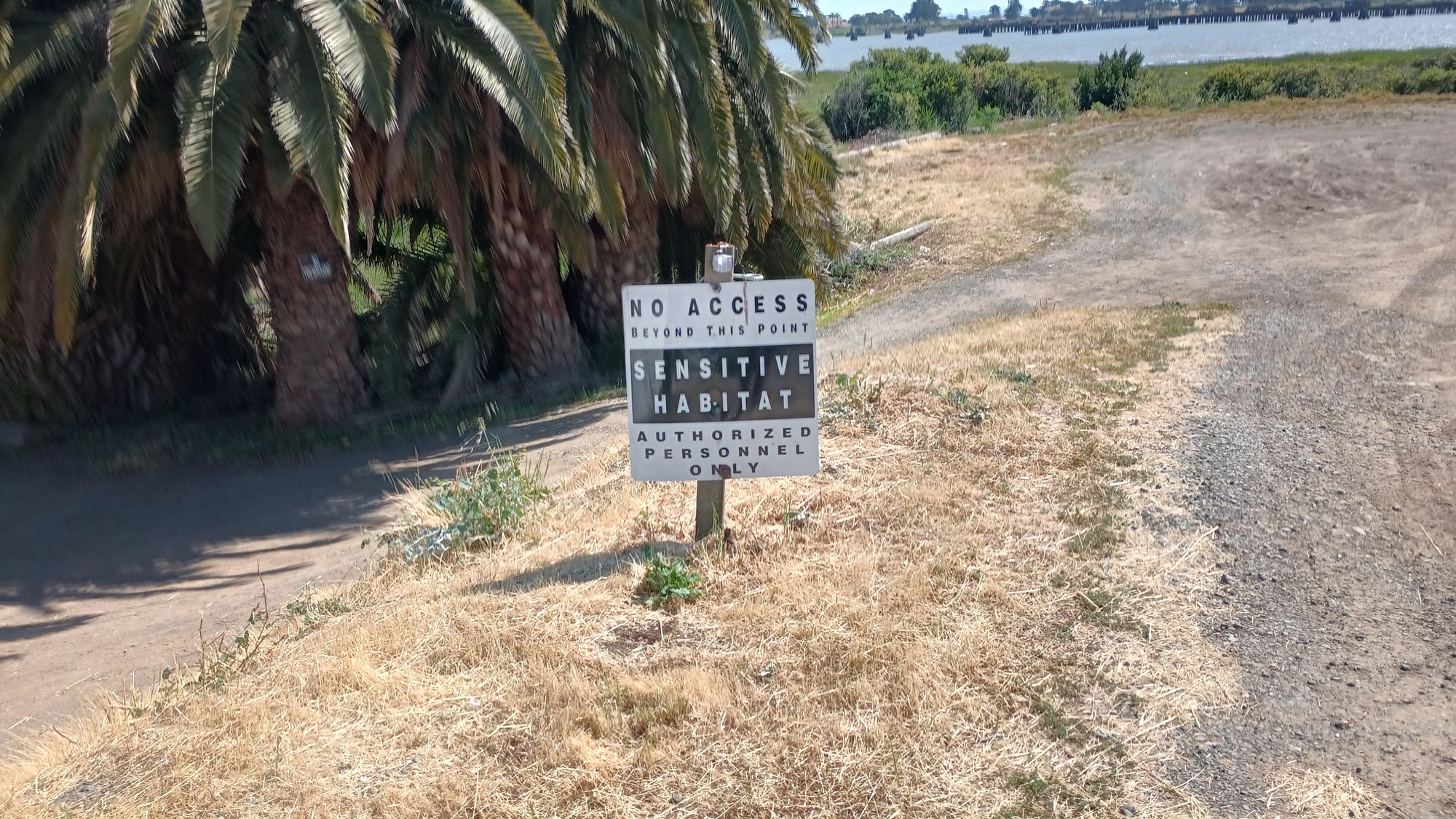
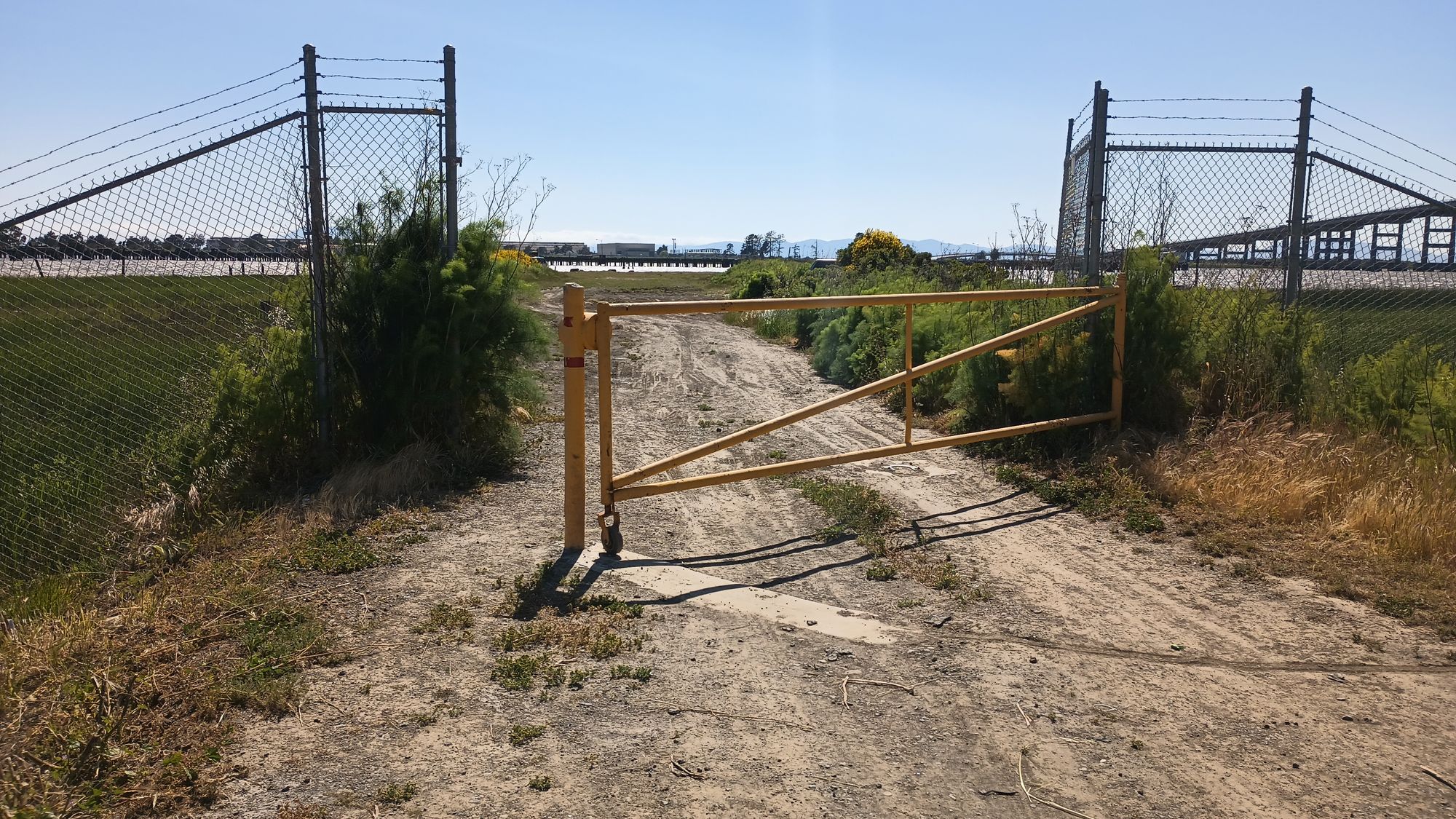
Left: Wilson Avenue boat ramp satellite view from Google Maps. Center: An anonymous warning sign at parking area. Right: Gate opening at the edge of the road. Photos by Gretchen Zimmermann
Conservation and Development Commission Sediment Program Analyst Pascale Soumoy said the case was closed when the gravel was removed. She said the commission would be supportive if the city wanted to make the site accessible to the public, but they would have to go through the typical application process.
Other agencies would have to check if there are any sensitive species in the area, but Soumoy said she doesn’t think that those obstacles are insurmountable.
“It's not as though they'd be cutting through a virgin marsh. It's already there. I think it's just a matter of communicating what you want and actually having the will and the drive for the city to do it,” Soumoy said.
The commission has even issued permits to develop in the area. Realtor Tim Hiemstra owns the neighboring hillside lot above the same marsh, and he said he recently acquired all necessary permits from the commission, the U.S. Army Corps of Engineers and the State Lands Commission to build three waterfront homes, an office, and a dock that he plans to open to the public.
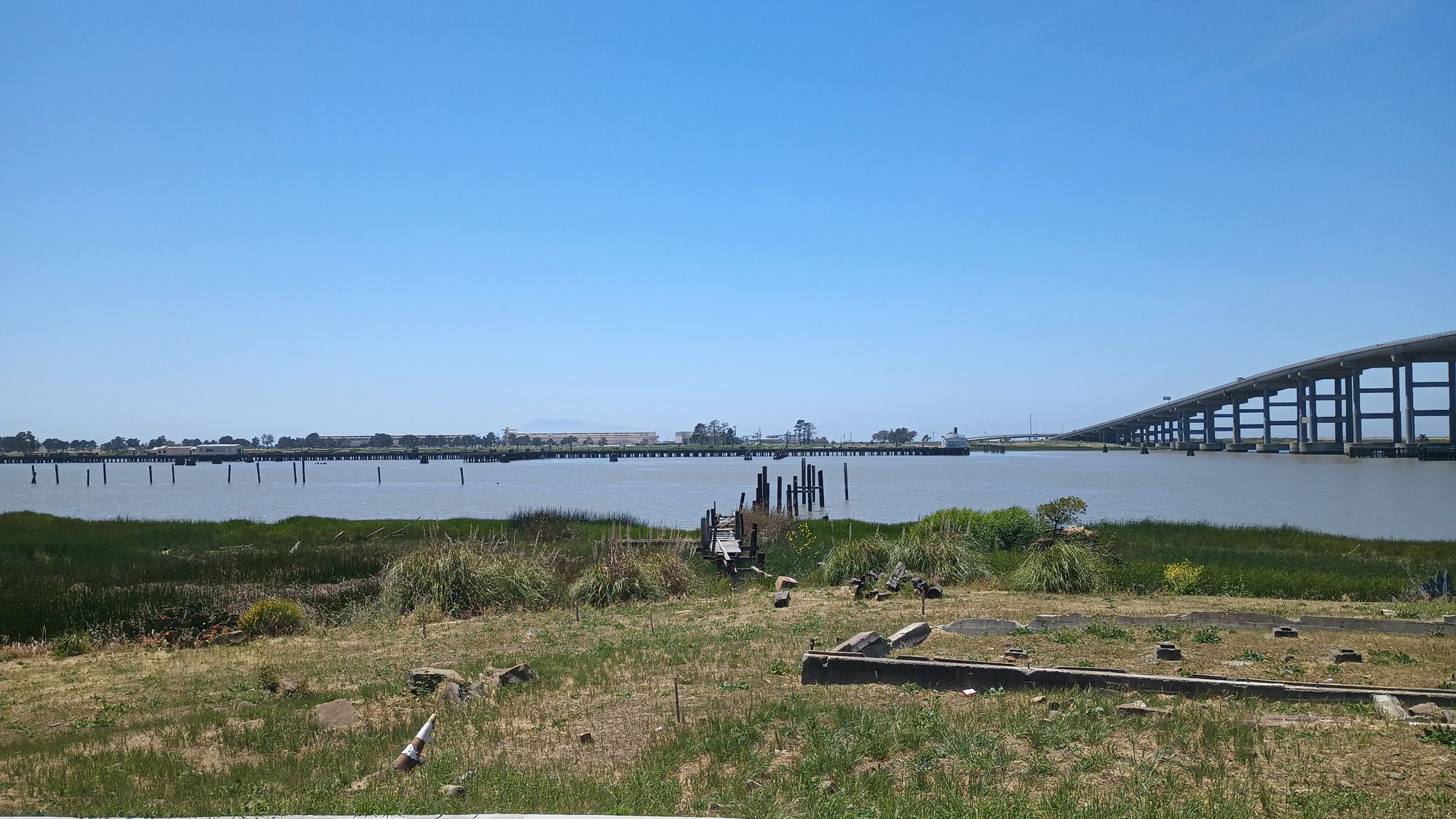
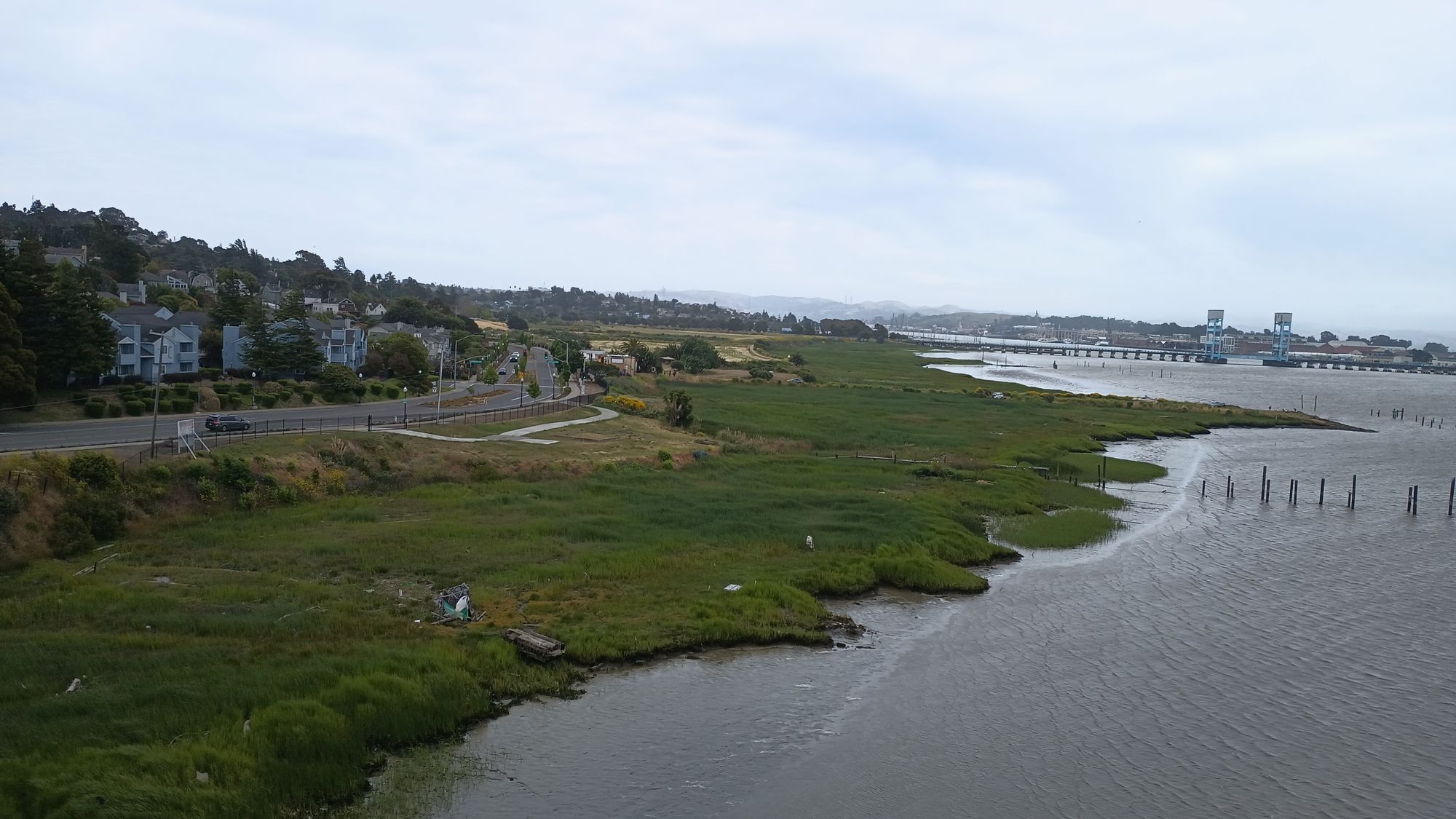
Left: Looking across the marsh and the river from Hiemstra's lot next to the Highway 37 bridge. Right: View from Highway 37 over Hiemstra's lot, the point where the embattled boat launch is located, and Mare Island Causeway in the distance. Photos by Gretchen Zimmermann
Davis, now assistant city manager, told the Vallejo Sun in an email that the city has no plans to unlock the gate for easier kayak access, and stated that “the area is restricted from vehicle traffic to protect the native environment and maintain security for public use.”
Executive Assistant to the City Manager Melissa Rhodes wrote in an email to city councilmembers in March 2021, before the current gate was installed, that the Conservation and Development Commission had received complaints “about dumping, and other illicit and criminal activity at the site because of uncontrolled vehicle access.”
“Obviously, since we are not in the parks business, we need to work with the State to explore a long term management plan/lease with [the Greater Vallejo Recreation District] or some other group to operate the site,” Rhodes wrote.
Souza agrees. He said he has been advocating for the parks district to manage the area, pointing out that they manage the nearby River Park and employ someone to open the parking lot in the morning and lock it at sunset.
Steve Dunsky, a media producer for the U.S. Forest Service, visits Vallejo regularly for his work with the Visions of the Wild festival and the Forest Service on Mare Island. He said Souza and his kayak group had patrolled the area, making sure that it wasn't getting trashed.
“It's one of the few places where you can put in safely, so it just seemed like a really good spot to do that, and the Sunshine Smoothies guy was all in favor because it would bring people to his business,” Dunsky said. “I just think that it's just a shame that that kind of fell apart and it doesn't seem like there's been any progress.”
Little cove next to the old Sperry Mill
General Mills kept a small cove north of the old Sperry Mill on Derr Street well-maintained for public swimming and fishing until the mill closed in 2004, according to Souza. “That’s where I learned how to swim when I was like two years old,” he said.
But the cove has deteriorated since.
Trees shade three picnic tables surrounded by weeds above the little beach’s high tide line. An abandoned motor boat is beached on the shore, the crumbling cement steps that lead down from the street are hidden by tall grass, and the porta-potty on the street nearby is covered in graffiti.
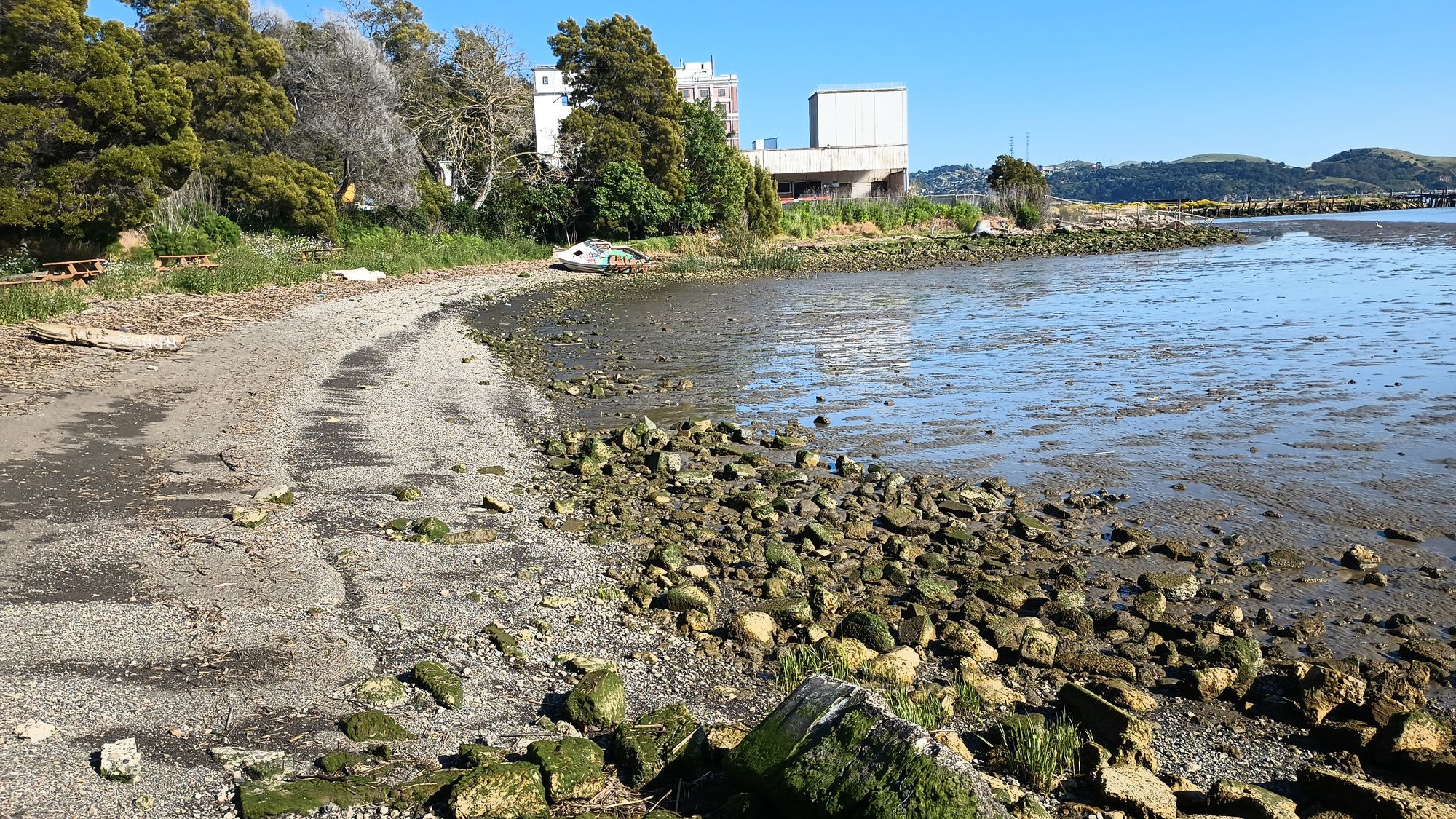
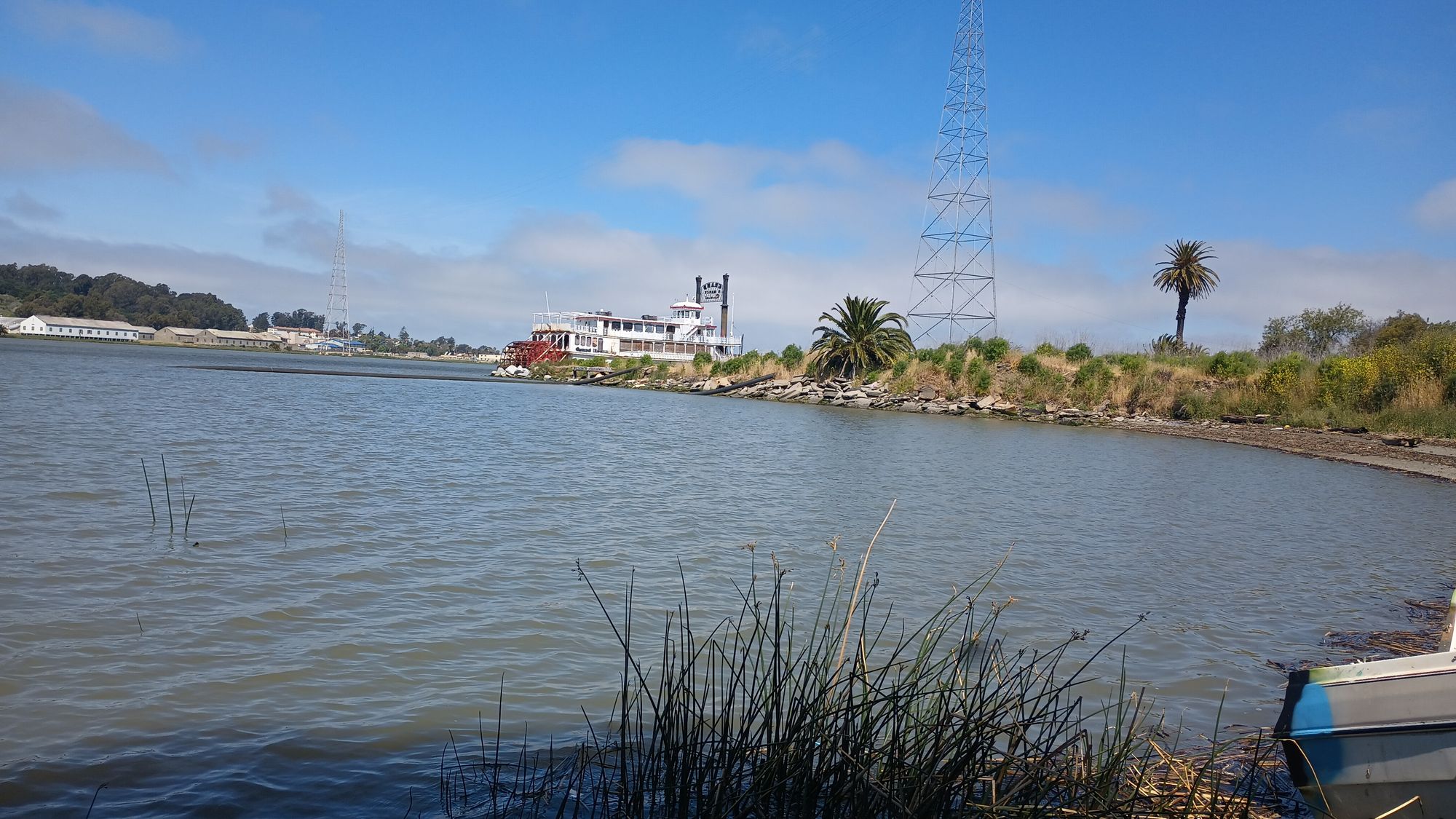
Derr Street cove looking southward to the old Sperry Mill, and north to where the Grand Romance riverboat is beached. Photos by Gretchen Zimmermann
Former Vallejo Mayor Bob Sampayan wanted the kayak group to be able to use the cove to launch, and they began cleaning up trash and weeds to restore it, Souza said. But during a low tide Souza saw that the bay was full of enough silt to make kayak launching impractical.
The area could be a pleasant waterfront park, but it is surrounded by derelict marine debris and industrial decay.
Two big dredging pipes dangle into the water from the hillside north of the cove. They run from the bay along the railroad tracks past the beached and rotting Grand Romance riverboat, past a cove where a tugboat has been idle for so long ospreys are nesting in its tower, and past several graffitied old barges and a chain-linked fenced junkyard filled with rusting marine equipment, old boat parts and shipping containers.
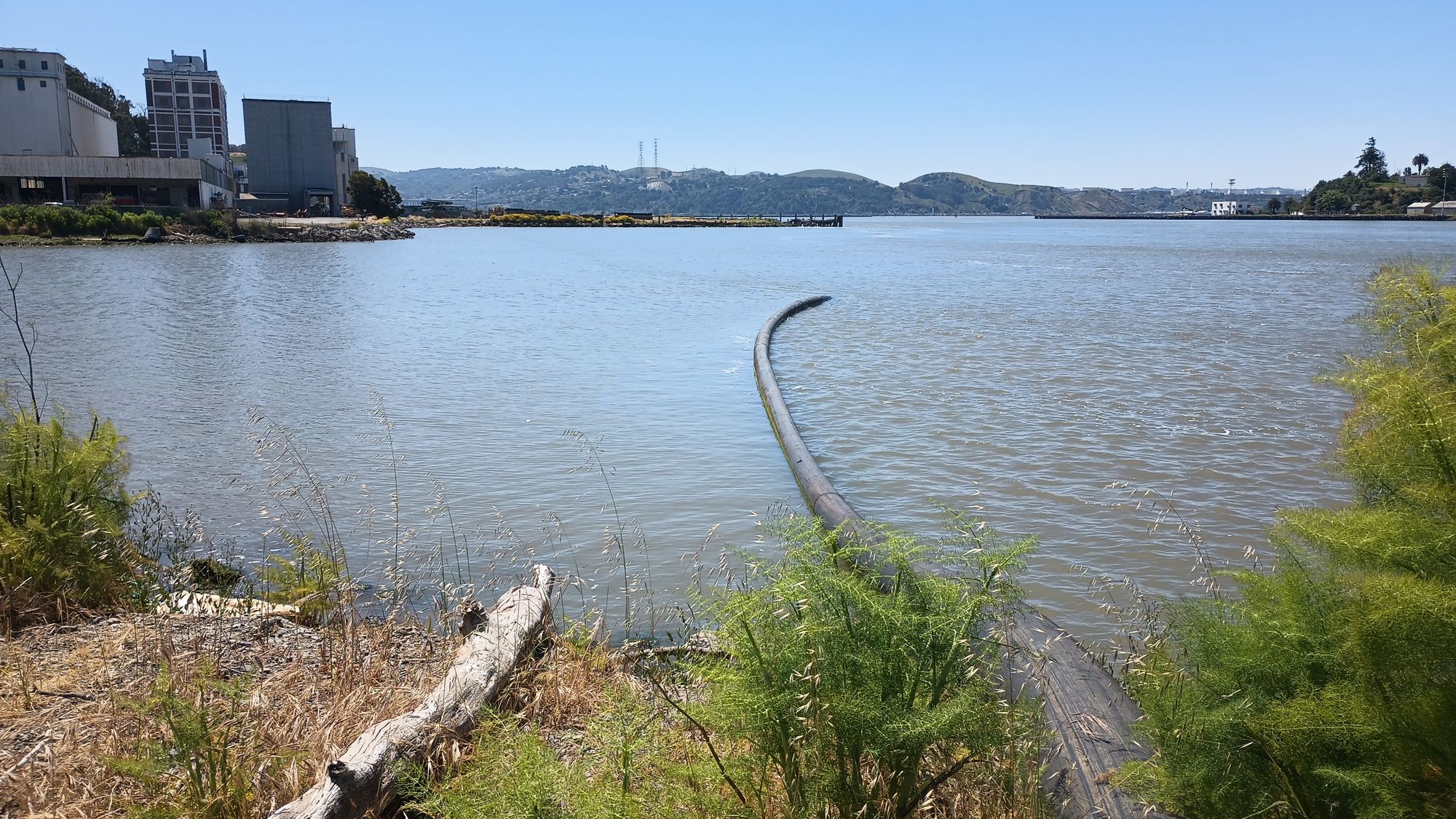
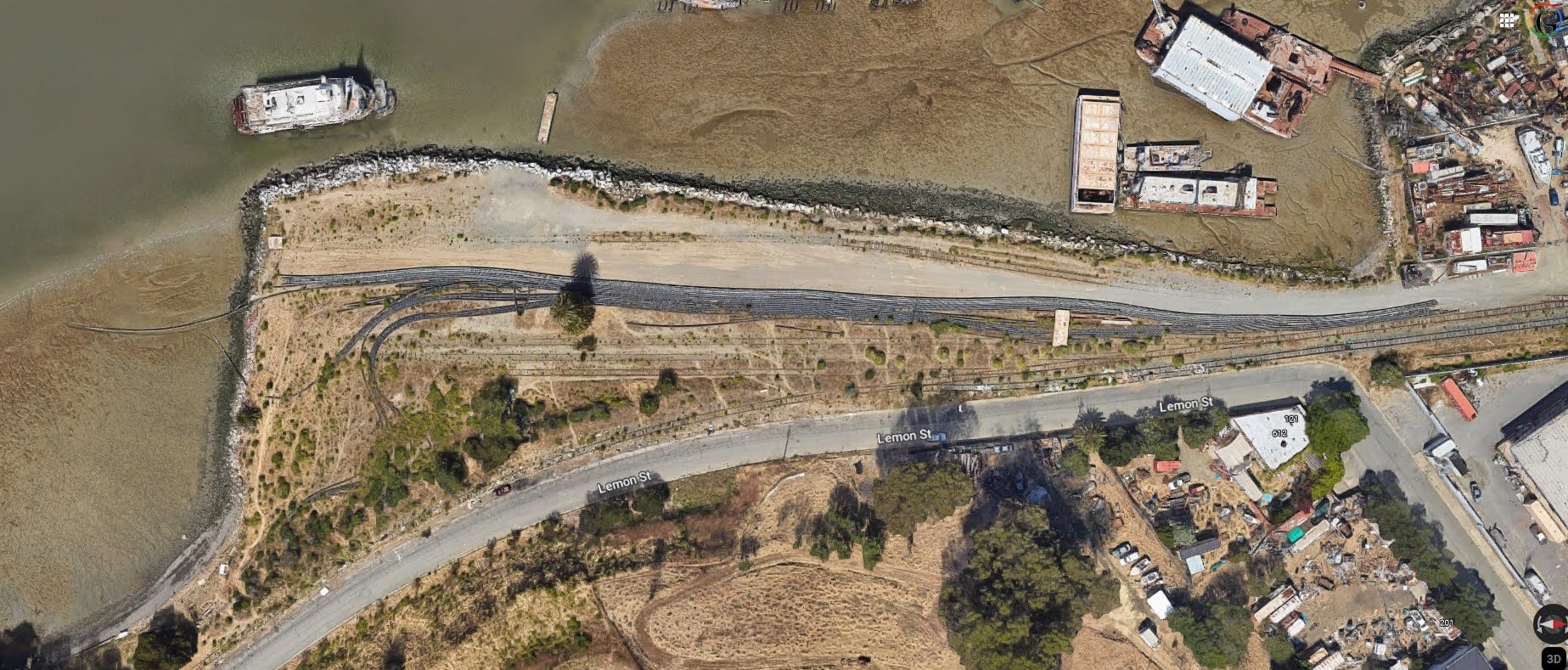
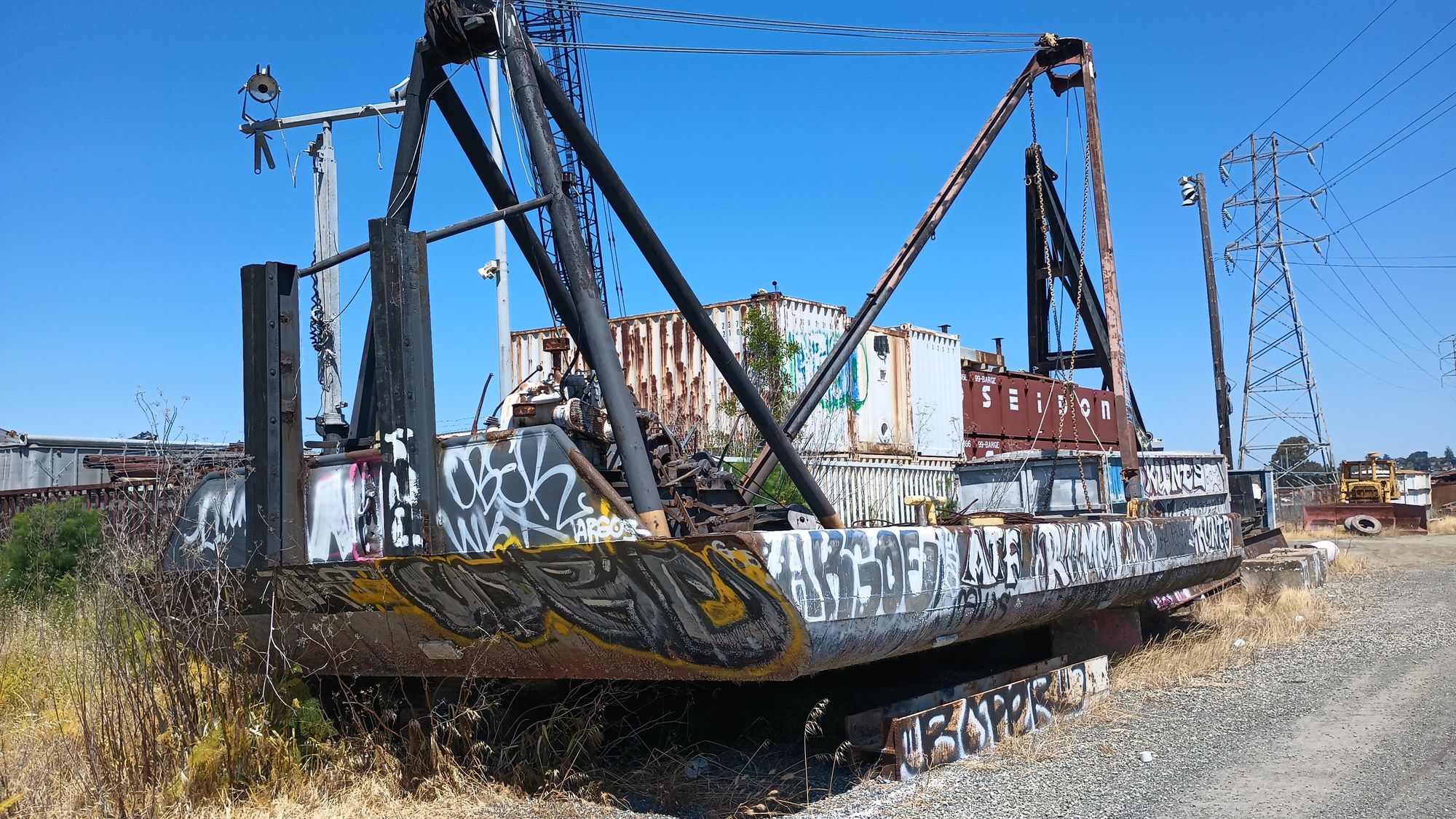
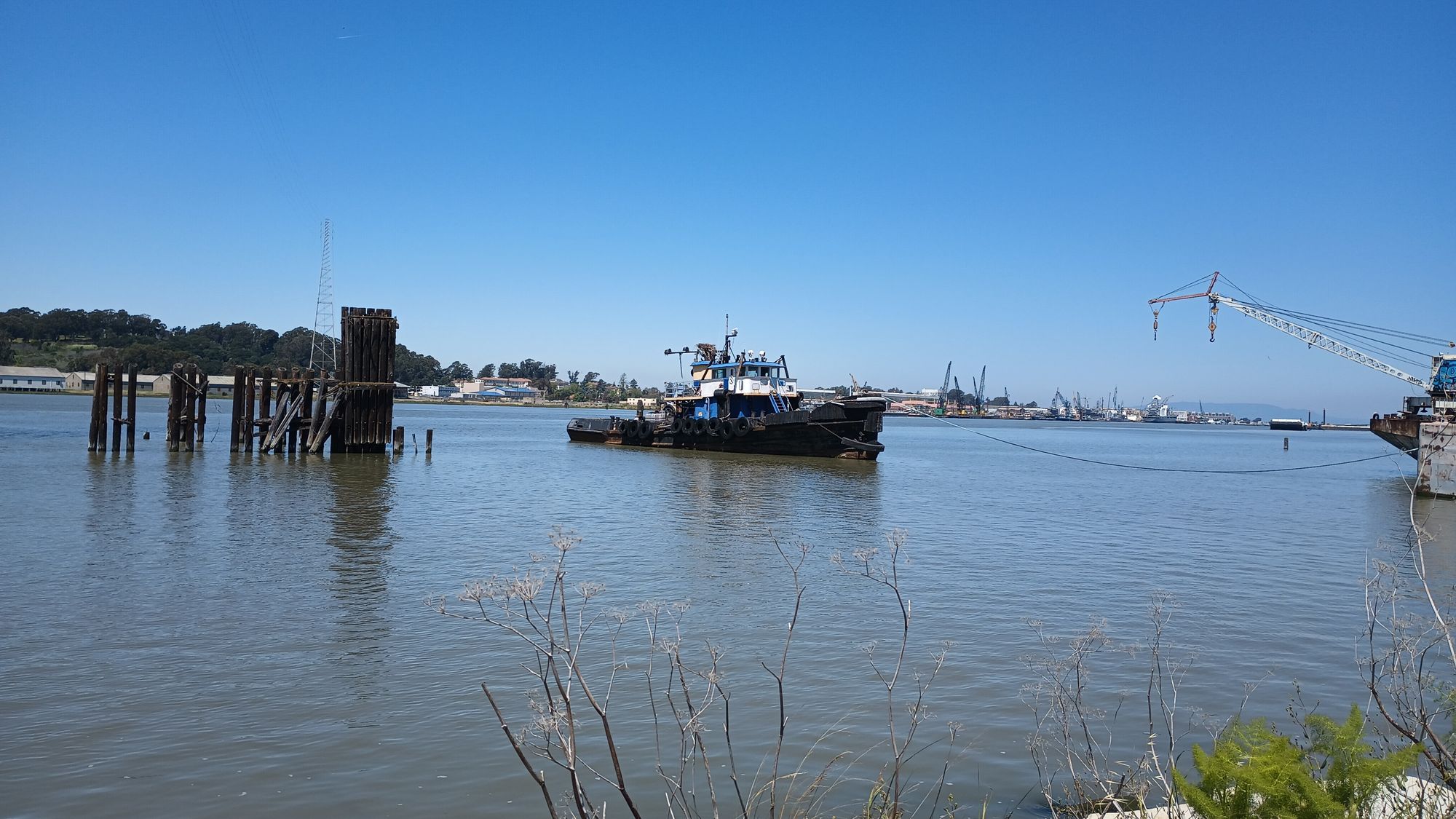
Dredging pipe dangles into the cove from the railroad tracks above. A derelict barge graces the nearby shoreline, and ospreys have built a net atop a stationary tugboat. Photos by Gretchen Zimmermann
The pipes belong to Camenzind Dredging, Inc., which has occupied the old 7-Up bottling plant on Chestnut Street for 20 years. Owner Kurt Camenzind said he has permission from the railroad to store the pipes there. They drag the pipes out when they need to use them for a job and pull them back up on land when they’re done.
But what about Mare Island?
The entire Mare Island shoreline was off limits to recreational boaters when it was a naval base. That hasn’t changed since the base’s closure in 1996 and transfer to the City of Vallejo in 2002.
Southern California-based developer Lennar was contracted by the City of Vallejo in 1998 to develop 650 acres that includes the seawall on the Mare Island Strait. Most restrictions to public access of the island were lifted by the late 2000s after Lennar and the Navy completed environmental cleanup.
Kayakers were able to tie up to ladders that the Navy had installed on the seawall as a safety measure to visit the island. But Lennar objected, citing liability reasons, according to Souza. “If anyone falls in, you want to be able to get out, so they put ladders up,” Souza said. “Well, Lennar took off all the goddamned ladders.”
Mare Island Project Manager Erin Hanford tried to help Souza establish sanctioned kayak access at one of the two old Navy slipways at the Mare Island Historic Core. But a month later Hanford told Souza that an upcoming land transfer would disrupt those plans.
The new owner, Nimitz Group LLC, held several community informational sessions conducted by design firm HOK from June through November of 2019, shortly after acquiring the island property from Lennar.
“At those meetings, they promised a bunch of kayak access,” Souza said. “When I asked the Nimitz Group about it, they said that company wasn't the developer, it was just the planning company.”
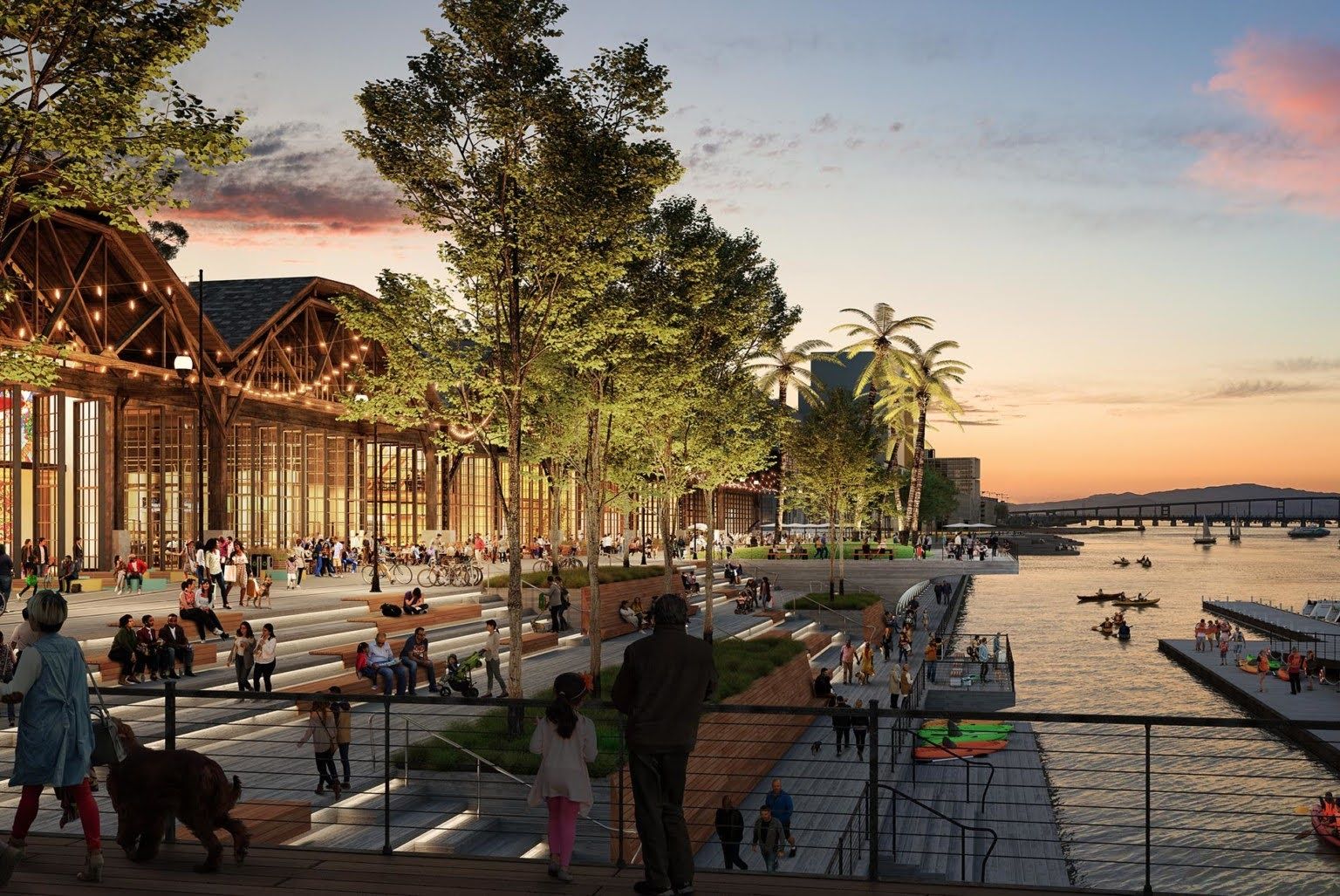
Nimitz Group shifted their focus the following year to study how existing buildings could be repurposed as factories and hotels, and identified North Mare island as the “front door” where Highway 37 and the Mare Island Causeway connect vehicle traffic to the island. Thomas D’Alesandro, president of West Coast operations for Southern Land told North Bay Business Journal, “I said to HOK to put their pencils down because we want to better understand the market drivers to shape the master plan.”
The Mare Island Company now represents both Nimitz and Mare Island developer Southern Land Company. The Mare Island Company wrote in an email to the Vallejo Sun that it “believes that some form of a dock would well serve the new vision for Mare Island.”
“Of course, it’s too early to identify locations or details for such a facility, as government and regulatory agencies will need to weigh in on our plans,” the company said.
Souza considered kayak access at the Mare Island shoreline north of the causeway, outside of the Lennar-owned property. “There are cement piers where the battleships were,” Souza said. “The city said we could use them. Then Erin [Hanford] calls me up and says ‘Steve, I can't believe this happened, but when the Navy sold North Mare Island to Vallejo, this guy up in Sacramento slapped on the Endangered Species Act for the entire north of Mare Island.’”
“That means no one can go near the water at all. You can't walk, you can't bike, you can't fish. You can't do anything,” Souza said. Souza said he’s completely in favor of protecting endangered species. “But on a battleship pier, give me a frickin’ break. You don't even walk on any plant life. There's no dirt, it's all cement.” Souza said.
The 1998 Environmental Impact Report for the Disposal and Reuse of Mare Island Naval Shipyard protects the California Clapper Rail (now known as Ridgway's Rail) and Salt Marsh Harvest Mouse.
The Navy still owns the southern end of the island and it is completely off limits, with warning signs about hazardous materials posted around the perimeter. It was used for munitions storage and still requires extensive environmental cleanup.
The western side of the island is part of the San Pablo Bay National Wildlife Refuge. There are no trails to the shore through the surrounding marsh. The closest launching site on that side of the bay is the Cullinan Ranch Boat Launch to the west of Vallejo on Highway 37.
Learning from the past and looking forward
Some positive developments may be in store for Vallejo boaters.
The City of Vallejo approved a waterfront development by the Wintun Nation in December 2022. They plan to replace the waterfront dentist office near the ferry terminal with a restaurant and cultural center and have agreed to help the city develop the Waterfront History Park in the weedy lot to the south dubbed by locals as “Pigeon Poop Park.”
Voters approved $395,000 for improvements to the park during the 2015-2016 Participatory Budgeting cycle. The finalized plans include two floating docks for non-motorized watercraft.
Four historic ships owned by the National Park Service will be anchored at Mare Island while their home at Hyde Street Pier in San Francisco is being renovated. The ships have potential to bring tourist dollars to Vallejo.
But problems will persist as long as Vallejo grapples with decades-long development delays, and multi-million dollar budget shortfalls that result in costly deferred maintenance and blight on its waterfront. In December, the city’s contract with a developer tasked with rehabilitating the waterfront ended after more than 20 years and little work accomplished, leaving the city starting from scratch and seeking a new developer for the expansive project.
Dunsky, the former Vallejo resident who works for the U.S. Forest Service, said the inattention to the waterfront contradicts the city’s stated goals of economic development.
“We talk all the time about economic development, we talk about attracting young people to downtown, we talk about having a thriving downtown business district,”Dunsky said. “Well, who's gonna want to go there if you can't access basic recreational opportunities? It's not really a question of money. It's a question of inertia and supposed priorities.”
This article was corrected to note that Steve Dunsky is a media producer for the U.S. Forest Service
Before you go...
It’s expensive to produce the kind of high-quality journalism we do at the Vallejo Sun. And we rely on reader support so we can keep publishing.
If you enjoy our regular beat reporting, in-depth investigations, and deep-dive podcast episodes, chip in so we can keep doing this work and bringing you the journalism you rely on.
Click here to become a sustaining member of our newsroom.
THE VALLEJO SUN NEWSLETTER
Investigative reporting, regular updates, events and more
- government
- environment
- Terrance Davis
- Melissa Tigbao
- Vallejo Municipal Marina
- Mare Island Company
- Vallejo Waterfront
- San Francisco Bay Water Trail
- Northern California Pirate Festival
- Stephanie Gomes
- Vallejo Yacht Club
- Vallejo Kayaking and Biking
- 400 Mare Island Way
- Brenda Plechaty
- Mare Island Heritage Trust
- Myrna Hayes
- Vallejo City Council
- Vallejo City Hall
- Margaret Cromwell
- Rekha Nayar
- PG&E
- Tom Bartee
- Michael Nimon
- U.S. Army Corps of Engineers
- Water Emergency Transportation Authority
- Thomas Hall
- John Garamendi
- Stephen Souza
- David Belef
- Kennith Wright
- State Lands Commission
- Greg Nyhoff
- Melissa Rhodes
- Greater Vallejo Recreation District
- Steve Dunsky
- General Mills
- Bob Sampayan
- Camenzind Dredging
- Kurt Camenzind
- Lennar
- Erin Hanford
- Nimitz Group
- HOK
- San Pablo Bay National Wildlife Refuge
- Yocha Dehe Wintun Nation

Gretchen Zimmermann
Gretchen Zimmermann founded the Vallejo Arts & Entertainment website, joined the Vallejo Sun to cover event listings and arts and culture, and has since expanded into investigative reporting.
follow me :




